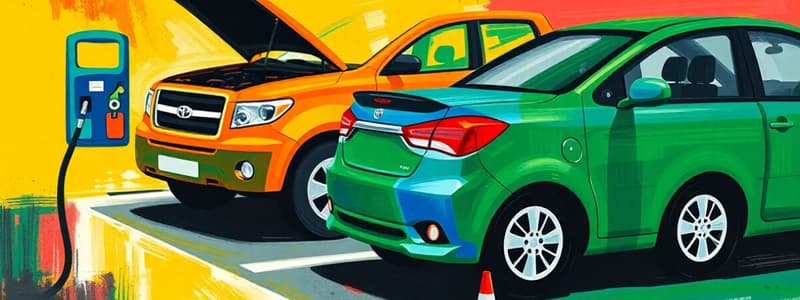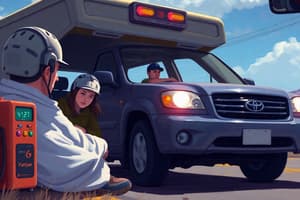Podcast
Questions and Answers
What is the primary reason for maintaining your vehicle with economy in mind?
What is the primary reason for maintaining your vehicle with economy in mind?
- To ensure your vehicle always looks its best
- To impress other drivers with your responsibility
- To reduce harmful exhaust emissions (correct)
- To increase your car's horsepower
Why is excessive idling discouraged when starting a modern vehicle?
Why is excessive idling discouraged when starting a modern vehicle?
- It significantly reduces the vehicle's battery life
- It's required to activate the vehicle’s security system
- Modern vehicles warm up quickly and do not require extended idling (correct)
- Idling can erase modern vehicle diagnostic codes
How does accelerating slowly and smoothly affect fuel consumption and exhaust emissions?
How does accelerating slowly and smoothly affect fuel consumption and exhaust emissions?
- It decreases fuel economy and increases exhaust emissions.
- It has no impact on fuel economy but increases exhaust emissions.
- It increases fuel economy and decreases exhaust emissions. (correct)
- It decreases fuel economy and reduces exhaust emissions.
How does using cruise control on highways contribute to fuel efficiency?
How does using cruise control on highways contribute to fuel efficiency?
Under what conditions should cruise control be avoided to maintain safety?
Under what conditions should cruise control be avoided to maintain safety?
How does using overdrive gear, unless towing or climbing a steep grade, impact fuel economy?
How does using overdrive gear, unless towing or climbing a steep grade, impact fuel economy?
Why is it beneficial to lift your foot off the accelerator early when approaching a stop?
Why is it beneficial to lift your foot off the accelerator early when approaching a stop?
Why is it important to look ahead along your intended path of travel?
Why is it important to look ahead along your intended path of travel?
How can combining trips into one day affect fuel consumption?
How can combining trips into one day affect fuel consumption?
What is the effect of underinflated tires on fuel economy and tire wear?
What is the effect of underinflated tires on fuel economy and tire wear?
Where can drivers typically find the recommended tire air pressure for their vehicle?
Where can drivers typically find the recommended tire air pressure for their vehicle?
What is the most effective way to decide on what tires to purchase for your vehicle?
What is the most effective way to decide on what tires to purchase for your vehicle?
Why is it important to maintain your vehicle according to the manufacturer’s specifications?
Why is it important to maintain your vehicle according to the manufacturer’s specifications?
Why is regular lubrication and filter changes important for an engine?
Why is regular lubrication and filter changes important for an engine?
Excessive wear of tread edges may mean what?
Excessive wear of tread edges may mean what?
Flashcards
Economical Vehicle Operation
Economical Vehicle Operation
Operating a vehicle efficiently, safely, and economically to save money and be environmentally friendly.
Avoid Idling
Avoid Idling
Avoid idling for long periods to conserve fuel.
Smooth Acceleration
Smooth Acceleration
Accelerate slowly and smoothly to conserve fuel.
Cruising Speed
Cruising Speed
Signup and view all the flashcards
Overdrive Gear
Overdrive Gear
Signup and view all the flashcards
Minimize Steering
Minimize Steering
Signup and view all the flashcards
Early Deceleration
Early Deceleration
Signup and view all the flashcards
Look Ahead
Look Ahead
Signup and view all the flashcards
Route Planning
Route Planning
Signup and view all the flashcards
Vehicle Preparation
Vehicle Preparation
Signup and view all the flashcards
Tire Types
Tire Types
Signup and view all the flashcards
Proper Inflation
Proper Inflation
Signup and view all the flashcards
Recommended Tire Air Pressure
Recommended Tire Air Pressure
Signup and view all the flashcards
Tire Tread Depth Measurement Using a Quarter
Tire Tread Depth Measurement Using a Quarter
Signup and view all the flashcards
Purchasing Tires
Purchasing Tires
Signup and view all the flashcards
Study Notes
Chapter Objectives
- The chapter provides information on how to minimize fuel use, reduce exhaust emissions, check and maintain tires, and maintain a vehicle.
Efficient, Safe, and Economical Vehicle Operation
- Operating vehicles efficiently, safely, and economically is important.
- Controlling fuel and maintenance costs can lead to substantial savings and be more environmentally friendly.
- Exhaust emissions are harmful; driving with economy and vehicle maintenance are critical for optimal efficiency.
Strategies for Economical and Environmentally Responsible Driving
- Driving habits significantly affect fuel usage.
- Fuel-saving habits can improve fuel economy and reduce environmental impact.
- Consider habits related to starting, idling, accelerating, cruising speed, overdrive gear, steering, turning, and braking.
Starting, Idling and Accelerating
- Avoid excessive idling when starting a vehicle.
- Modern vehicles only need a few seconds for fluids and engines to warm up without risk of damage.
- Avoid idling for long periods.
- Vehicles use the most fuel when accelerating.
- Accelerate slowly and smoothly to increase fuel economy and decrease exhaust emissions.
- When possible, pull through parking spots to minimize the number of accelerations from a dead stop.
Cruising Speed and Overdrive Gear
- Vehicles run most efficiently at constant speeds.
- Vehicles achieve maximum fuel economy on highways because of less speed change.
- Maintain adequate space and use cruise control when possible to keep the vehicle moving at a constant speed.
- Some vehicles have advanced cruise control that adjusts speed based on the space ahead.
- Avoid cruise control in rainy or slick conditions.
- Cruise control maintains speed and does not allow slowing by lifting off the accelerator.
- Use overdrive gear unless towing or climbing a steep grade.
- Overdrive gear minimizes engine revolutions and increases fuel economy.
Steering and Turning
- Turning the steering wheel causes the vehicle to change direction and creates friction, slowing the vehicle.
- Avoid unnecessary steering wheel movement.
Braking and Additional Techniques
- When slowing down or stopping, lift off the accelerator early, possibly avoiding brake use.
- Avoid driving at a higher speed and then braking harder than necessary near the stopping point
- Additional fuel-saving techniques include:
- Looking ahead to minimize speed changes and identify risks.
- Route planning and combining destinations for more efficient trips.
- Reducing the number of trips per week.
- Remove roof racks and other attachments to decrease wind resistance and improve mileage.
Tire Safety
- Tires are essential for acceleration, turning, and braking.
- Tires touch the ground and are required for any driving maneuver.
- Tires have two or more layers of cords covered by rubber tread.
- Tire design and construction vary to meet different driving styles and conditions.
- Use high-quality tires with adequate tread and replace when necessary; mixing tire types is not recommended.
Proper Inflation
- Check tire pressure monthly with an accurate gauge, including the spare tire.
- Check tire pressure when tires are cold.
- Carry an accurate tire gauge.
- A 20% underinflation decreases fuel economy and has the same effect on a tire as a 30% increase in speed.
- Inflating tires to recommended pressures for long-distance, high-speed travel increases tread life.
- Find the vehicle's recommended tire pressure in the owner's manual or on a placard on the driver doorjamb, glove box, or fuel filler door.
Tire Tread Depth
- On smooth, clean, dry surfaces, amount of tread doesn't have much of an impact on braking distance and traction.
- On wet surfaces, snow, and mud, tread depth is a critical traction factor.
- Adequate tread depth helps evacuate water from under tires.
- Low tread depth doubles the risk of hydroplaning and increases the likelihood of blowouts.
- Bald tires are twice as likely to go flat as new tires.
- To check tread depth, use a quarter. If part of Washington's head is always covered, the tires have more than 4/32" of tread depth and are safe.
- Replace tires if the top of Washington's head is exposed.
How to Purchase Tires
- Research tires thoroughly before buying.
- Do not only base your purchase decision on cost; consider quality, tread life, and temperature and traction ratings.
- Quality and safety are the most important factors when buying tires.
Vehicle Maintenance and Prevention
- Vehicles are significant investments that should be maintained to keep them safe and reliable.
- Maintain the vehicle according to the manufacturer's specifications and look out for signs that something is not working properly.
- Repair issues before major breakdowns occur; prevent problems before they occur.
Under the Hood
- Regular maintenance may require checking:
- Engine coolant reservoir (radiator fluid)
- Windshield washer fluid reservoir.
- Power-steering fluid reservoir.
- Drive belts.
- Engine-oil filler cap.
- Engine-oil dipstick.
- Transmission-fluid dipstick (if equipped).
- Brake fluid reservoir.
- Battery cable connections.
- Air-filter assembly
- Failure to conduct these checks can lead to unsafe operating conditions and costly repairs.
- Consult the owner's manual to verify what components should be inspected.
- Perform these checks at least once a month or as recommended in the owner's manual.
Vehicle Systems
- Familiarize yourself with vehicle systems to monitor and detect when something is not operating properly.
- Vehicle maintenance focuses on various systems.
Key Information for Effective Maintenance
- Exhaust System:
- Minimize tailpipe emissions.
- Check the exhaust pipe, catalytic converter, muffler, and tailpipe for pinholes, rust, and looseness.
- A leaking muffler can allow carbon monoxide to enter the vehicle.
- Lubricating System:
- Engine oil serves two purposes: It lubricates, and it cools.
- Follow the vehicle's owner's manual regarding regular lubrication, filter changes, and the grade and weight of oil to use.
- Cooling System:
- Ensures the engine temperature is controlled for maximum efficiency.
- Too much heat can destroy an engine, and too little robs it of power and fuel economy.
- Electrical System:
- Electrical system failures are the most common cause of breakdowns.
- Regular maintenance can prevent electrical system problems.
- Braking System:
- Essential for safety.
- How well the brakes work and how much they wear depends on driving habits.
- Address potential brake system issues immediately.
- Tires:
- Uneven tire wear indicates that the wheels need to be aligned or balanced.
- Steering wheel vibrations suggest the wheels need to be balanced.
- Excessive wear of tread edges can indicate underinflation.
- Wipers and Bulbs:
- Ensuring your wiper blades and light bulbs function properly to see and be seen is critical for safety.
- Replace wiper blades and check turn signals, flashers, brake lights, headlights, and taillights at least each month.
Trusted Service Centers and Maintenance Checklist
- Finding a trusted vehicle maintenance and repair facility is a good idea.
- Such centers can handle routine service needs, including regularly checking vehicle systems.
- People who drive an average of 12,000 miles a year should take 15 minutes each month to check various items affecting safety and efficiency.
What to Check
-
Daily:
- Window: Check for cracks, scratches, dirt, pits.
- Brakes: Listen for pedal pressure/travel and any squeaking sounds..
- Exhaust: Listen for noise and check for fumes and leaks..
- Steering: Check for steering wheel play, stiffness in steering..
- Lights: Look for dirty lens, burned out bulbs, alignment..
-
Weekly:
- Tires (including spare tire): Check for air pressure, cuts, tread wear, alignment..
- Items under the hood: Check fluids, hoses, belts, filters, connections.
-
Monthly:
- Wipers: Wiper blade condition and washer fluid level..
-
Annually:
- Suspension: Check for excessive bouncing, leaning, swaying..
-
Properly care for all other vehicle systems according to the manufacturer's specifications and schedule.
-
Note that maintenance intervals may vary with different makes and models.
-
Read the owner's manual carefully, and follow the maintenance schedule for a specific vehicle and driving habits to help reduce costly repairs, increase fuel economy, and emit less harmful exhaust.
-
The less the vehicle is maintained, the less reliable it will be, and the more the vehicle will cost you in the long run.
Studying That Suits You
Use AI to generate personalized quizzes and flashcards to suit your learning preferences.




